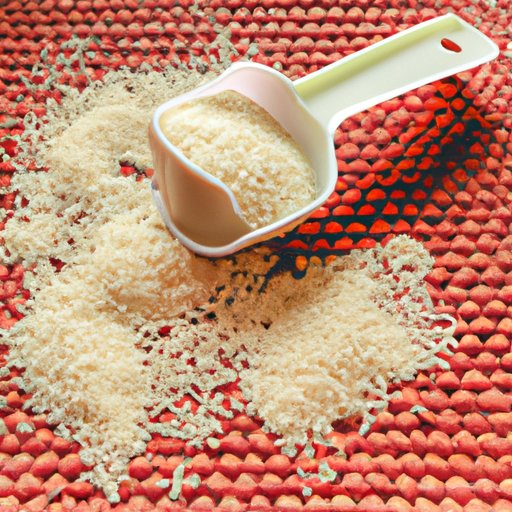
Introduction
Sesame seeds are a flavorful and nutrient-dense ingredient that have been a staple in diets across the globe for centuries. However, as gluten-free diets have become increasingly popular, questions often arise about whether or not sesame seeds contain gluten. In this article, we’ll explore the nutritional benefits of sesame seeds, how they can be incorporated into gluten-free recipes, and why they are a great addition to any diet.
Benefits of Including Sesame Seeds in a Gluten-Free Diet
Sesame seeds are a rich source of nutrients, including copper, manganese, calcium, and magnesium. They’re also packed with healthy fats and protein, making them a great addition to any diet, especially for those following a gluten-free diet. Consuming sesame seeds may help promote heart health by reducing inflammation, cholesterol, and blood pressure levels. They have also been shown to support bone health and may help with reducing inflammation in the body.
Including sesame seeds in a gluten-free diet can also help fill nutritional gaps. Many gluten-free products lack essential vitamins and minerals that are found in wheat, such as iron and B vitamins. However, incorporating sesame seeds into your meals and snacks can help provide these essential nutrients.
How to Incorporate Sesame Seeds Into Gluten-Free Recipes
There are a variety of ways to include sesame seeds in both sweet and savory gluten-free recipes. One easy way to start is by sprinkling sesame seeds on top of salads, porridge, or roasted vegetables for added crunch and flavor. Tahini paste, made from ground sesame seeds, can be used as a dip or sauce for vegetables or as a spread for bread. Sesame oil can also be used in stir-fries or dressings to add a rich nutty flavor.
For those looking for recipe inspiration, here are a few ideas:
– Sesame Seed Bars: perfect for a quick snack or breakfast on the go.
– Sesame-Crusted Fish: coat your favorite fish fillet in sesame seeds for a crispy and flavorful crust.
– Sesame Ginger Tofu: marinate tofu in a sesame ginger sauce for a tasty and protein-packed meal.
The Science Behind Why Sesame Seeds Are Gluten-Free
Grains such as wheat, barley, and rye all contain gluten, a protein that can be difficult to digest for those with gluten sensitivities or celiac disease. Sesame seeds, on the other hand, are naturally gluten-free. Gluten is found in the endosperm of these grains, which nourishes the plant embryo during germination. In contrast, sesame seeds are a type of seed that does not contain endosperm and therefore does not contain gluten.
Debunking Common Myths about Gluten-Free Foods and Sesame Seeds
There are many misconceptions about gluten-free foods, such as that they are not flavorful, healthy, or easy to find. However, this is not always the case. Gluten-free foods can be just as tasty and nutritious as gluten-containing foods. Sesame seeds are a versatile ingredient that can be used in a wide variety of foods, from snacks to baked goods, and can add both flavor and nutrients to your diet.
Exploring the Nutritional Value of Sesame Seeds for Individuals on a Gluten-Free Diet
Sesame seeds are an excellent source of protein, fiber, healthy fats, vitamins, and minerals. They contain all nine essential amino acids, making them a complete protein source, which is especially beneficial for those on a plant-based or gluten-free diet. In addition, they are rich in antioxidants like vitamin E, which may help reduce inflammation in the body.
Including sesame seeds in a gluten-free diet can help meet daily nutrient requirements. They are a great source of calcium, magnesium, and copper, minerals that are important for bone health. They are also rich in iron, a nutrient that is often lacking in gluten-free diets.
Highlighting Some Delicious Gluten-Free Sesame Seed Snacks and Meals
Looking for some recipe or snack inspiration? Here are a few ideas to get you started:
– Sesame Crackers: these are a great gluten-free alternative to store-bought crackers.
– Sesame Granola Bars: a healthy and delicious snack that can be made in advance for on-the-go.
– Sesame-Crusted Chicken: coat your chicken breast in sesame seeds for a crispy and flavorful twist on a classic dish.
The Versatility of Sesame Seeds for Both Gluten-Free and Non-Gluten-Free Cooking
Sesame seeds are incredibly versatile and can be used in a wide variety of dishes, whether you’re following a gluten-free diet or not. They’re commonly used in Asian-inspired dishes like stir-fries and noodles, but they can also be used in baked goods, sprinkled on top of salads, or used as a coating for meat or tofu. They provide a nutty and delicious flavor that can complement both sweet and savory dishes.
Conclusion
Incorporating sesame seeds into a gluten-free diet is easy and provides a variety of health benefits. Whether you’re looking to add more nutrients to your diet, or you’re simply looking for a versatile ingredient to add to your meal repertoire, sesame seeds are an excellent choice. So why not try incorporating them into your next meal or snack?
One final tip: try making your own sesame seed butter by blending toasted sesame seeds in a food processor until they form a smooth and creamy paste.




